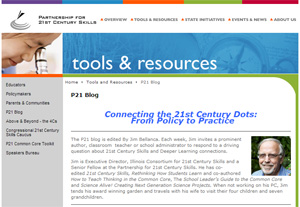In the not-so-distant past—December 18, 2006—the headline on the cover of Time magazine enticed readers to learn, “How to Build a Student for the 21st Century.” Inside, authors Claudia Wallis and Sonja Steptoe noted that the national conversation around education at the time focused on ensuring that no students were “left behind” rather than how American children would be able to compete in a global economy which required the abilities to work in teams, think abstractly and reason through problems, analyze the quality of information and communicate in a language other than English. Wallis and Steptoe (2006) identified the 21st century skills students need to be successful and suggested that teachers need to bring their methods and the curriculum “in line with the way the modern world works” (p.56).

Seven years later, readers of the P21Blog: Connecting the 21st Century Dots: From Policy to Practice are asked again to consider the needs of students who must learn both the 3Rs (content knowledge) and the 4Cs (Creativity and Innovation, Critical Thinking and Problem Solving, Communication and Collaboration) to be successful in the 21st century workplace (Partnership for 21st Century Skills, n.d.). The P21 Blog, an outgrowth of over a decade of work by a coalition of educators, business leaders and policy makers to improve 21st century readiness, addresses issues surrounding the implementation of 21st century skills and deeper learning in American schools. Beginning this academic year, the P21 Blog, housed on the website of the Partnership for 21st Century Skills, doubled its posts to provide weekly information that focused on answering a driving question about implementing 21st century skills.
The thoughtful entries offered by a growing group of education experts, business leaders and more recently classroom educators from the P21 Exemplar Schools, are definitely worth reading. Topics include book reviews, policy discussions and most importantly practical articles addressing implementation of 21st century skills in real classrooms. Educators will find entries like “How Can Technology Empower Deeper Learning in a 21st Century School?” and “How Do Teachers Become Deeper Learners?” valuable as they consider how to incorporate critical thinking and problem-based learning activities in their instructional plans. Although commenting on blog entries is encouraged by Jim Bellanca, blog editor and Executive Director, Illinois Consortium for 21st Century Skills and Senior Fellow at the Partnerships for 21st Century Skills, few readers are taking advantage of this opportunity. One thing is evident in reading through the posted comments—divergent opinions are accepted and open for discussion. In addition to commenting, readers are invited to contribute anonymous posts to the blog as “The Secret Educator” taking any position for or against 21st century learning practices and policies. Contributors are asked to be respectful in their discourse and prepared to accept pushback on their point of view. The P21 Blog clearly has potential to become a significant resource and discussion forum for those seeking information about the needs of 21st century learners.
References
Partnership for 21st Century Skills. (n.d.) The champion for today’s students and tomorrow’s workforce. Retrieved from http://www.p21.org/storage/documents/P21_2013_Brochure.pdf
Wallis, C. & Steptoe, S. (2006, December 18). How to bring our schools out of the 20th century. Time, 168(25), 50-56.
 Joan A. Rhodes is an Associate Professor and Chair of the Reading Program at Virginia Commonwealth University.
Joan A. Rhodes is an Associate Professor and Chair of the Reading Program at Virginia Commonwealth University.
This article is part of a series from the International Reading Association Technology in Literacy Education Special Interest Group (TILE-SIG).